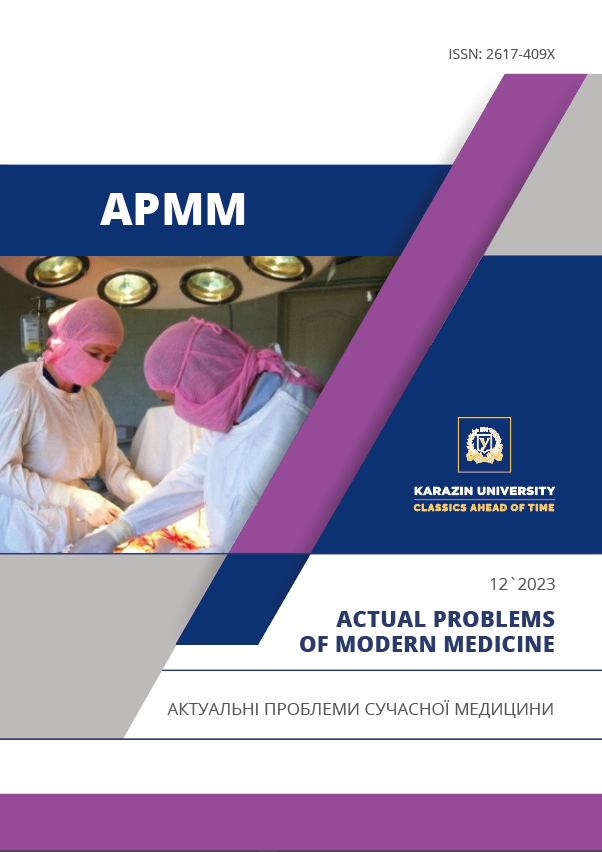Options of the course of post-COVID syndrome depending on age, gender, comorbidity and severity of the course of COVID-19
Abstract
ABSTRACT. Among residents of Chernivtsi region, the main characteristics, frequency and peculiarities of the occurrence of long-term symptomatic and post-COVID-19 syndrome have not been sufficiently elucidated. The goal of the study was set: to evaluate the options for the course of the post-covid syndrome depending on age, gender, comorbidity and severity of the course of COVID-19. Material and methods. The following research methods were used: electronic questionnaire, epidemiological, clinical and anamnestic, analytical and statistical methods. The study included 214 adult patients who were infected with the SARS-CoV-2 virus (the diagnosis was confirmed by PCR) and who suffered from COVID- 19 of varying degrees of severity and were randomized into two groups: the 1st group (main) included – 112 people (ratio of men/women - 56.4 % (n = 63): 47.5 % (n = 49)), comparative (102 people) – patients with a mild and moderate course of COVID-19 who were consulted and were treated on an outpatient basis (male/female ratio – 45.5 % (n = 46): 54.5 % (n = 56)). Statistical processing of the data obtained during the research was carried out using the IBM SPSS Statistics v26.0 program. Results. It was found that among inpatients there was a significantly significant number of patients older than 60 years old (p < 0.001), whereas among outpatients there were significantly more patients aged 18-29, which indicates a connection between the age of the respondents and the need for inpatient treatment presence of COVID-19. In the main group, the following symptoms occurred more frequently (p < 0.05): cough OR = 2.023 [CI 1.105-3.703], fever OR = 6.916 [CI 2.061-23.204], difficulty breathing (dyspnea) OR = 4.421 [2.230 -8.764]. In the comparison group, the following prevailed: loss of smell OR = 0.147 [CI 0.077-0.281], fatigue OR = 0.456 [CI 0.226-0.920], increased temperature OR=2.023 [2.061- 23.204]. With a higher frequency, such diseases as: coronary heart disease (OR = 33.088 [CI 9.444-115.930]), arterial hypertension (OR = 13.641 [CI 6.547-28.422]), diabetes (OR = 4.755 [CI 1.915-11.803]), heart failure (OR = 18.504 [CI 8.200-41.752]), obesity (OR = 4.828 [CI 2.433-9.581]). Conclusions. 1. Among the patients who received inpatient treatment, the vast majority were people over 40 years old, younger men (from 40 years old) were more likely than women (over 60). 2. In persons with a severe course of COVID-19, the frequency of symptoms of shortness of breath, cough, difficulty breathing, chest pain is more likely to be registered, and in outpatients - loss of smell and fatigue. 3. With a greater frequency, such diseases as: coronary heart disease (37.5 %), arterial hypertension (57.4 %), diabetes (21.3 %), heart failure (54,1 %), obesity (41.1 %). Smoking and alcohol abuse did not show significant reliable differences. 4. The combination of 3 pathologies (hypertension, heart failure, obesity) was most common - in 11 people (10 %).
Downloads
References
Protsyuk RG, Vlasova-Protsyuk GJ, Galan IO. COVID-19: prevention of infection and spread. Tuberculosis Lung disease HIV-infection. 2022;4(51): 30-5. DOI: https://doi.org/10.30978/TB2022-4-30 [in Ukrainian].
Pavli A, Theodoridou M, Maltezou HC. Post-COVID syndrome: Incidence, clinical spectrum, and challenges for primary healthcare professionals. Arch Med Res. 2021; 52(6):575-81. doi: https://doi.org/10.1016/j.arcmed.2021.03.010
Todoriko LD, Feshchenko YuI, Semіaniv IO, Kuzhko MM, Shevchenko OS, Lyubevich RL. Peculiarities of the pathogenesis of coronavirus infection and prognosis regarding the pathomorphosis of pulmonary tuberculosis in the conditions of the COVID-19 pandemic. Ukr Pulmonol Journal. 2022;(2-3):12-22. DOI: https://doi.org/10.31215/2306-4927-2022-30-2-12-22 [in Ukrainian].
Moreno-Pérez O, Merino E, Leon-Ramirez JM, Prunier L, Cavelier G, Thill MP, et al. COVID19-ALC research Post-acute COVID-19 Syndrome. Incidence and risk factors: A Mediterranean cohort study. J Infect. 2021 Mar;82(3):378-83. doi: https://doi.org/10.1016/j.jinf.2021.01.004
Klok FA, Boon GJAM, Barco S, Endres M, Geelhoed JJM, Knauss S, еt al. The Post-COVID-19 Functional Status (PCFS) Scale: a tool to measure functional status over time after COVID-19. Eur Respir J. 2020 Jul; 56(1): 2001494. doi: https://doi.org/10.1183/13993003.01494-2020
Holubovska OA. Postkovidnyі syndrom: patohenez ta osnovni napryamy reabilitatsiyi. Medychna hazeta "Zdorovya Ukrayiny". 2021; 2(495) [in Ukrainian].
Shevchenko OS, Todoriko LD, Petrenko VI, Kiba VP, Pohorielova OO. COVID-19 and mental disorders: mechanisms of development and possibility of detection: a review. Tuberculosis Lung disease HIV-infection. 2021;2(45):52-9. URI: http://dspace.bsmu.edu.ua:8080/xmlui/handle/ 123456789/17875 [in Ukrainian]
Todoriko LD, Ostrovskyi MM, Semianiv IO, Shevchenko OS. Features of tuberculosis in a COVID-19 pandemic. Tuberculosis Lung disease HIV-infection. 2020;4(43):52-63. DOI: https://doi.org/10.30978/TB2020-4-52 [in Ukrainian]
Komaroff A. The tragedy of the post-COVID “long haulers”. https:// www.health.harvard.edu/blog/the-tragedy-of-the-post-covid-longhaulers-2020101521173
Gupta A, Madhavan MV, Sehgal K, Nair N, Mahajan S, Tejasav S, et al. Extrapulmonary manifestations of COVID-19. Nat Med. 2020; 26:1017–32. doi: https://doi.org/10.1038/s41591-020-0968-3
Covid-19-Long-Term-Health-Effects. [(accessed on 7 May 2021)]; Available online: https://www.gov.uk/government/publications/covid-19-long-term-health-effects/covid-19-long-term-health-effects
Shah W, Hillman T, Playford ED, Hishmeh L. Managing the long term effects of COVID-19: summary of NICE, SIGN, and RCGP rapid guideline. Brit Med J. 2021; 372: n136. doi: https://doi.org/10.1136/bmj.n136
Carfi A, Bernabei R, Landi F. “Gemelli Against COVID-19 Post-Acute Care Study Group. Persistent symptoms in patients after acute COVID-19”. JAMA. 2020; 324(6):603-5. doi: https://doi.org/10.1001/jama.2020.12603
Cheung KS, Hung IFN, Chan PY, Lung KC, Tso E, Liu R, et al. Gastrointestinal manifestations of SARS-CoV-2 infection and virus load in fecal samples from a Hong Kong cohort: systematic review and meta-analysis. Gastroenterology. 2020 Jul; 159(1): 81–95. doi: https://doi.org/10.1053/j.gastro.2020.03.065
Eysenbach G. Improving the Quality of Web Surveys: The Checklist for Reporting Results of Internet E-Surveys (CHERRIES). J Med Internet Res. 2012;14(1):e8. doi: https://doi.org/10.2196/jmir.2042
Velavan T, Meyer C. The COVID-19 epidemic. Trop Med Int Health. 2020;25(3):278-80. doi: https://doi.org/10.1111/tmi.13383




